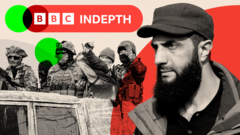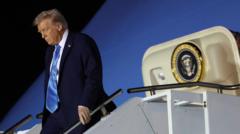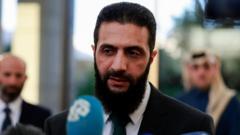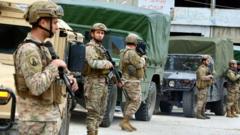The leadership of Hayat Tahrir al-Sham (HTS), now under Ahmed al-Sharaa, is navigating a delicate balance between reforming their image for international legitimacy and appeasing hardline factions, sparking debates about the group's commitment to a more inclusive future.
A Reformed Past? The Future of Syria's HTS Under Al-Sharaa

A Reformed Past? The Future of Syria's HTS Under Al-Sharaa
As Syria's rebel leaders attempt to distance themselves from their jihadist roots, questions arise about their true intentions and ability to fulfill the aspirations of a diverse populace.
In recent weeks, Syria's new leader Ahmed al-Sharaa, previously known as Abu Mohammed al-Jolani, has stirred conversation in the region by calling for a shift away from the extremist ideologies that historically characterized Hayat Tahrir al-Sham (HTS). During a public appearance in Damascus, a young woman requested a photograph with him, leading to a notable incident where he asked her to cover her hair. This moment quickly sparked intense discussions on Arabic and mainstream media, shedding light on the precarious position that HTS finds itself in today.
With HTS classified as a terrorist organization by several global entities, including the UN, US, and UK, the group's leadership is under pressure to maintain legitimacy amidst a backdrop of internal and external scrutiny. Al-Sharaa's actions have raised concerns among the Syrian populace, particularly regarding whether policies under HTS will evolve towards stricter conservative measures forcing adherence to Islamist norms, such as mandatory veiling for women.
On one hand, international and liberal factions seek a more progressive and inclusive governance model. Conversely, hardline Islamists within HTS criticize al-Sharaa's approach, viewing it as a betrayal of foundational jihadist principles. This internal conflict represents a critical test for HTS as it works to reconcile the expectations from both local populations and its more radical base.
Al-Sharaa’s communications focus heavily on fostering coexistence within Syria's multifaceted society, which includes Kurds, Christians, Druze, and other minority groups in addition to the dominant Sunni Arabs. His strategies have included granting amnesty to dissenters and using neutral language in addressing past adversaries such as Israel and Iran. However, many observers question whether these moves symbolize a genuine ideological shift or are merely calculated strategies aimed at consolidating power.
Despite efforts to evolve from a militant faction towards a semblance of governance, HTS continues to face notable challenges, including ongoing grievances from local populations regarding its governance and military tactics. Many residents report dissatisfaction with the group's oppressive measures and conformity demands, including the establishment of a public morality police which mandates dress codes for women, sparking fears of reverting to a more jihadist identity.
HTS has historically grappled with disunity among various rebel groups, and recent initiatives to work alongside rival factions could help mitigate these internal rifts, albeit with risks of fragmentation still looming. For HTS, power struggles and shifting alliances are fundamental hurdles as they continue navigating this turbulent landscape.
Through deft maneuvering, al-Sharaa stands poised to either redefine HTS's relationship with the Syrian state or provoke backlash from hardliners who demand a more stringent implementation of Islamist law. The dual pressures exerted by moderates urging reform and extremists advocating for the preservation of religious authority will force HTS to maintain a delicate equilibrium.
Al-Sharaa’s directive thinking remains unclear; his recent engagements with liberal figures alongside the persistent scrutiny from radical Islamist factions complicate predictions for HTS's future amidst fluctuating allegiances. The ongoing discourse in Syria surrounding HTS's legitimacy, intentions, and governance strategies underscores the ongoing fight for influence in a nation plagued by division and conflict.





















